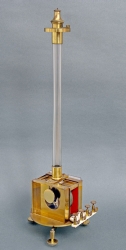Scientific Instrument Society 25th Anniversary Exhibition
Navigation:
<< First | < Previous | Next > | Last >>
20 A Weber Electrodynamometer, c. 1865
This instrument was purchased at the Scientific and Medical Instrument Fair in October 1987 and was the first ‘more serious’ acquisition in my collection of electrical measuring instruments. Its appeal lies in its elegant design and construction (typical of French instruments) and also because it was made by the noted Parisian instrument maker Heinrich Daniel Ruhmkorff (1803-1877).
The electrodynamometer was invented by Wilhelm Eduard Weber (1804-1891) in 1845 and uses two concentric coils (the inner one moving) to measure current in absolute terms, without the use of a fixed magnet. It was the first instrument capable of absolute measurement, meaning that a current could be calculated directly from the dimensions of the instrument and the force produced by the suspension. A more sophisticated version (now in the Science Museum) was constructed for the Electrical Standards Committee of the British Association in 1865 to make standard measurements of current, and was used in 1874 by Josiah Latimer Clark to determine the e.m.f. of his standard cell.
Private Collection, London
See: Weber, W.E., “Electrodynamische Maasbestimmungen”, Leipzig, 1845, Vol.1, p.16.
Objects lent by Anonymous Lender III, London:
24. Kelvin Multi-Cellular Electrostatic Voltmeter, by James White, Glasgow, c. 1895

